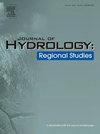GRACE 观测中亚蓄水的自然和灌溉引起的区域再分布情况
IF 4.7
2区 地球科学
Q1 WATER RESOURCES
引用次数: 0
摘要
研究地区中亚地区,被积雪和冰川覆盖的天山和帕米尔山脉是 "水塔",为下游人口稠密地区提供必要的淡水资源,主要用于夏季农业生产和冬季能源生产。研究重点利用六种 GRACE(-FO)解决方案中基于卫星的陆地蓄水量(TWS)变化和 MODIS 的积雪覆盖率,分析中亚地区从汇水区到水源区的蓄水空间动态,从而确定灌溉方法对大规模蓄水的影响。季节性 TWS 变化的空间模式表明,水从山区重新分布到下游农田灌溉地区。在这些地区,大多数 GRACE 解决方案观测到的夏季最大蓄水量可归因于将山脉流入的水分流到大片农田。全球资源共享行动能够观测中亚地区自然和人为造成的水重新分布情况,这表明它在水资源管理的区域级监测应用方面具有潜力。本文章由计算机程序翻译,如有差异,请以英文原文为准。
GRACE observes the natural and irrigation-induced regional redistribution of water storage in Central Asia
Study Region
Central Asia region, where snow and glacier covered Tian Shan and Pamir mountains serve as “Water Tower” to supply populated areas downstream with essential freshwater resources, predominantly for agricultural production in summer and for energy production in winter.
Study Focus
To identify the impact of irrigation practices on large-scale water storage by analyzing the spatial dynamics of water storage in Central Asia from sink to source using satellite-based Terrestrial Water Storage (TWS) variations from six GRACE(-FO) solutions and snow cover from MODIS.
New Hydrological Insights for the Region
Snow Cover Index (SCI), a new proxy index for snow accumulation shows that GRACE-based TWS dynamics agree very well with snow accumulation and melt for seasonal and inter-annual variations. The spatial patterns of seasonal TWS variations show water re-distribution from the mountain region to the downstream parts, where agricultural fields are irrigated. In these areas, the maximum storage in summer observed with the majority of GRACE solutions can be attributed to the diversion of water inflow from the mountain ranges into vast areas of agricultural land. The ability of GRACE to observe both natural and human-induced water re-distribution in Central Asia indicates its potential for regional-scale monitoring applications in water resources management.
求助全文
通过发布文献求助,成功后即可免费获取论文全文。
去求助
来源期刊

Journal of Hydrology-Regional Studies
Earth and Planetary Sciences-Earth and Planetary Sciences (miscellaneous)
CiteScore
6.70
自引率
8.50%
发文量
284
审稿时长
60 days
期刊介绍:
Journal of Hydrology: Regional Studies publishes original research papers enhancing the science of hydrology and aiming at region-specific problems, past and future conditions, analysis, review and solutions. The journal particularly welcomes research papers that deliver new insights into region-specific hydrological processes and responses to changing conditions, as well as contributions that incorporate interdisciplinarity and translational science.
 求助内容:
求助内容: 应助结果提醒方式:
应助结果提醒方式:


